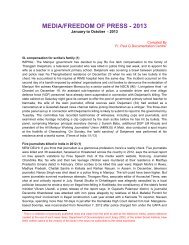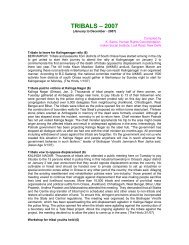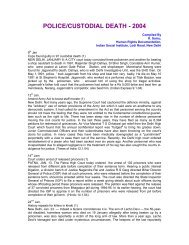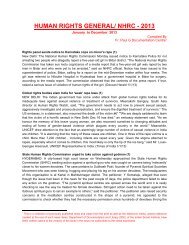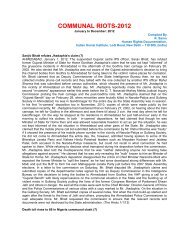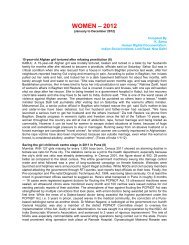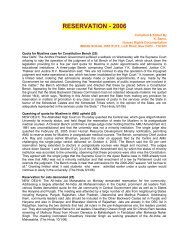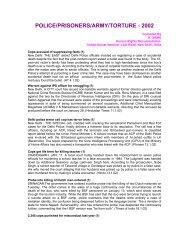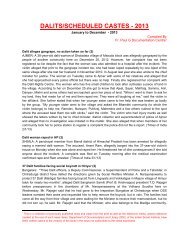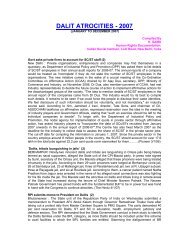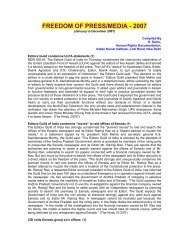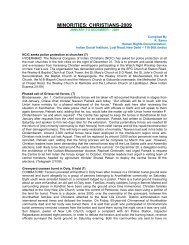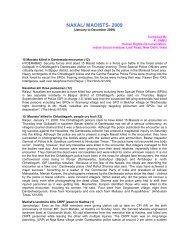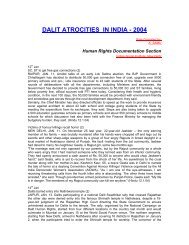EDUCATION - 2004 - Indian Social Institute
EDUCATION - 2004 - Indian Social Institute
EDUCATION - 2004 - Indian Social Institute
You also want an ePaper? Increase the reach of your titles
YUMPU automatically turns print PDFs into web optimized ePapers that Google loves.
she added. According to sources, experts have raised objections over several issues that have<br />
been included in the newly-introduced books. Earlier, contents of the third chapter of Civic<br />
Science textbook of Class 7 created a lot of controversy due to an interpretation of the citizenship<br />
issue. The chapter talks extensively on the difference between a foreigner and a citizen of the<br />
country. Experts believe that by raising these questions, efforts had been made to distort the very<br />
concept of citizenship. (Asian Age 18.12.04)<br />
23 rd Dec<br />
Most Orissa students leave school by Class 5 (11)<br />
Bhubaneswar, Dec. 22: : When India is making big stride in global education, Orissa continues to<br />
stumble in primary level. Last year, exactly 57.5 per cent of students have left their education by<br />
the time they attained standard 5. The school dropout rate is atrociously high even as the state<br />
government claims to have taken all possible steps to arrest the trend. Members of Orissa<br />
Legislative Assembly were shocked when the state school and mass education minister<br />
Nagendra Pradhan presented statistics of school dropouts last week. Nearly 33.6 per cent students<br />
had to leave their education in primary level — Standard three — in the year 2003-04.<br />
Ironically, the percentage of gross enrolment was 103.48 at primary level education. In case of<br />
girls, the percentage of dropout was high. Nearly 35.4 per cent of girl students left education<br />
midst as against 31.9 per cent of boys in primary level. The rate dramatically shot up in upper<br />
primary education. Almost 57.5 per cent students severed their ties with education by the time<br />
they complete standard five. Again the rate of dropout was high in case of girls. The rate of<br />
dropped out girl students was 58.6 per cent as against 56.5 per cent of in case of boys. In rural<br />
areas, the rate of dropout in upper primary was 60.92 per to the 48 per cent in urban Orissa.<br />
(Asian Age 23.12.04)<br />
27 th Dec<br />
NCERT body meets to review school syllabus (11)<br />
NEW DELHI, DECEMBER 26: THE two-day meet of the National Focus Group (NFG) formed by<br />
NCERT to review curriculum framework began today in the Capital. The group consisting 14<br />
members is meeting under the chairmanship of Prof. Vijaya Mulay, president, India Documentary<br />
Producers Association. The discussion will focus on the issues concerning educational technology<br />
programs in the country. And its implementation and status in the education format in cities<br />
and rural areas. The members of the group come from diverse organisations dealing with production<br />
and utilization of educational technology and media programmes. NFG is one of the 21<br />
groups formed to review the National Curriculum framework. Inaugurating the meeting, Prof<br />
Mulay said: "Educational technology must not be misunderstood with media and technological<br />
aids. Instead it involves active participation by teachers in preparation of curriculum framework.<br />
Numerous challenges are there in this exercise but we must review the curriculum within the<br />
broad guidelines of the constitutional framework and not as dictated by media". (<strong>Indian</strong> Express<br />
27.12.04)<br />
29 th Dec<br />
NCERT to launch scholarship programme to woo dropouts (11)<br />
New Delhi: The statistics say it all. As many as 54% of students drop out of schools between<br />
classes I and VIII. A staggering 69% drop out between classes I and X. The numbers get worse:<br />
Only 31% children appear for the class X public exam. And of them, only 40% pass.<br />
Universalisation of education or a colossal waste of resources? Prompted by the above figures —<br />
part of a MHRD report (Selected Educational Statistics, 2000-2001), the NCERT is planning to<br />
launch a programme for school dropouts. Modelled along the lines of the national talent search<br />
examination conducted by the NCERT for regular school students, this particular 'talent' search<br />
has a more basic agenda — of getting students back in the classrooms. Starting off as a pilot<br />
project from 2006, the programme is targeted at those who dropped out after completing class<br />
VIII. It will offer 100 scholarships to those who pass the qualifying exam. The scholarships will for<br />
studies till the post-graduate level. Said V K Jain, in-charge of the programme, "Every year, we<br />
keep losing students due to various reasons — financial problems at home, failure in school, etc.<br />
This programme will at least try to get the children back to school and pursue higher studies."



